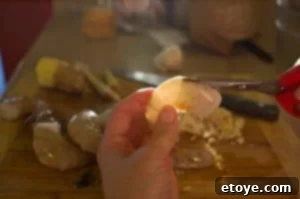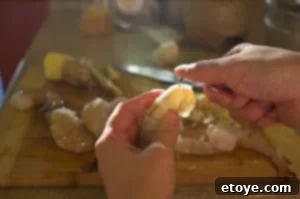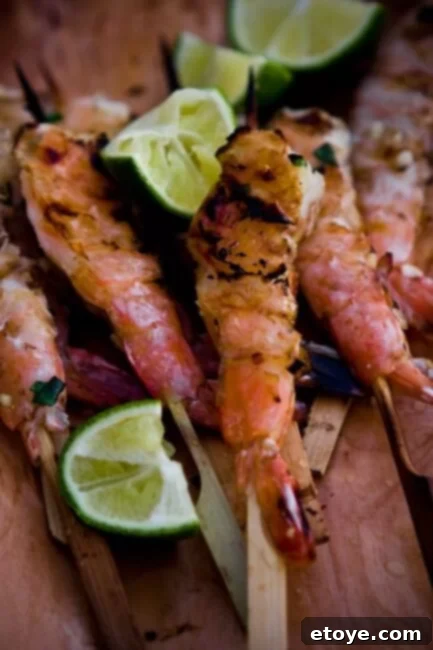
There’s an undeniable thrill that comes with discovering jumbo shrimp on sale. We’re talking about those truly colossal crustaceans, so substantial they could easily be mistaken for miniature lobster tails. For these magnificent monsters of the sea, there’s no better preparation than grilling them whole, shell-on, infused with the vibrant, aromatic flavors of a lemongrass and ginger marinade. This method not only enhances their natural sweetness but also protects their delicate texture, ensuring every bite is a juicy delight.
But how exactly do you prepare these impressive Lemongrass-Ginger Grilled Shrimp, especially when they’re so large and still in their shells? Many home cooks might feel intimidated by the thought of cleaning and deveining such substantial shrimp without removing the shell. Fear not, because the process is surprisingly straightforward, and I’m here to guide you through it, demonstrating exactly how to get these beauties ready for the grill.
Mastering the Art of Deveining Shrimp with Shell On
Deveining shrimp with the shell on might sound like a daunting task, but it’s actually quite simple, especially with larger shrimp. The bigger the shrimp, the more prominent and easier to locate the “vein” – which, for clarity, isn’t actually a vein but rather the shrimp’s digestive tract. While not harmful to consume, removing it vastly improves the aesthetic and often the taste, preventing any gritty texture. I’ll share two effective methods to achieve perfectly deveined, shell-on shrimp, ensuring your grilling experience is top-notch.

Before diving into the deveining techniques, a quick preliminary step enhances the overall cooking and eating experience: gently snip off the small, wispy feet from along the underside of the shrimp using a pair of kitchen shears. This simple act tidies up the shrimp and makes handling them a little easier.
Method #1: Precision Deveining with Kitchen Shears

For this method, you’ll need a pair of sharp kitchen shears, preferably with small, pointed tips. I personally adore my Joyce Chen Kitchen Shears for their precision. Begin by carefully snipping along the back of the shrimp’s shell, running the shears from just behind the head all the way down, stopping just before you reach the tail. The key here is not to cut too deeply; you want to split open the shell and expose the vein without severing it. A shallow cut ensures the vein remains intact, making it far easier to remove in one clean piece. Essentially, you are creating an opening along the shrimp’s dorsal side, revealing its digestive tract while keeping the shell mostly intact.

Once the shell is neatly split, you’ll find the dark digestive tract – the “vein” – easily accessible. Gently lift it out with your fingers or the tip of your shears. The beauty of this method is that the majority of the shell remains on, protecting the delicate shrimp meat during cooking and infusing it with extra flavor, while still allowing for easy access to the vein. This technique is particularly effective for those who appreciate the robust flavor and added moisture that cooking shrimp in their shells provides.
Method #2: The Toothpick Technique for Shell-On Deveining
If you prefer not to split the entire shell of the shrimp, or if you’re working with slightly smaller, yet still jumbo, shrimp, the toothpick method offers an elegant alternative. This technique is remarkably simple and leaves the shell virtually untouched, perfect for those who prioritize presentation and minimal disruption to the shrimp’s exterior.

To employ this method, take a clean, sturdy toothpick (or a thin skewer). Carefully insert the tip of the toothpick into the shrimp’s back, aiming for the area directly between two shell segments, just beneath where you can visually or physically locate the dark “vein.” You’ll want to penetrate just deep enough to hook the vein without tearing the surrounding flesh.

With the toothpick now engaged with the vein, gently pull upwards and outwards. The “vein” should lift out cleanly and entirely in one piece. Discard it immediately. This method is incredibly discreet, preserving the shrimp’s pristine appearance while ensuring it’s thoroughly cleaned. It’s a fantastic technique for those special occasions when both flavor and presentation are paramount. Whichever method you choose, remember to rinse the deveined shrimp under cold water and then pat them thoroughly dry before marinating to ensure the marinade adheres properly and they cook evenly.

Why Grill Shrimp with the Shell On?
Beyond simply making deveining easier, grilling shrimp with their shells intact offers several significant advantages that contribute to a superior culinary experience. Firstly, the shell acts as a natural barrier, protecting the delicate shrimp meat from the direct, intense heat of the grill. This helps to prevent overcooking and keeps the shrimp incredibly moist and tender. Without the shell, shrimp can dry out quickly, becoming rubbery and losing their succulent texture.
Secondly, the shell itself contributes to the flavor. As the shrimp cooks, the natural juices and oils from the shell infuse the meat, adding a deeper, more complex seafood flavor. This is particularly true when combined with a potent marinade like our lemongrass-ginger blend; the shell traps these aromatic essences, allowing them to penetrate deeper into the shrimp flesh. Lastly, there’s an element of engaging interaction when eating shell-on shrimp. Peeling them at the table adds to the enjoyment and creates a more authentic, rustic dining experience.
Lemongrass Ginger Grilled Shrimp: An Aromatic Delight
This recipe for Lemongrass Ginger Grilled Shrimp is a celebration of vibrant, fresh flavors, perfectly balanced with the natural sweetness of succulent jumbo shrimp. For those who enjoy a little kick, a finely minced fresh chili pepper or a dash of chili powder can be added to the marinade, elevating the heat profile without overpowering the main ingredients. The key to maximizing the flavor infusion lies in the fineness of your aromatic ingredients: the more finely you chop or grate the lemongrass, ginger, and garlic, the more their essences will permeate the shrimp.
To achieve the best results, I highly recommend using a microplane grater for the lemongrass and ginger, which extracts maximum flavor and creates an almost paste-like consistency. A good garlic press is invaluable for the garlic, ensuring it’s uniformly crushed and releases its full aroma. If fresh lemongrass is difficult to find, you can substitute it with 1 teaspoon of fresh lemon zest, though the unique herbal notes of lemongrass are truly irreplaceable. When it comes to grilling, bigger shrimp are definitely better, offering a more satisfying bite and a greater surface area for charring. While I advocate for grilling or broiling with the shell on to protect the delicate meat and enhance flavor, feel free to remove the shell before marinating if that’s your preference, or opt for already shelled shrimp for convenience. Just be mindful that cooking times might be slightly shorter for pre-shelled shrimp.
Ingredients:
- 1 large stalk lemongrass, outer leaves discarded, bottom 3 inches finely minced or grated
- 1-inch piece of fresh ginger, peeled and finely minced or grated
- 2 or 3 cloves garlic, finely minced or pressed
- 1 stalk green onion (scallion), finely minced
- 2 tablespoons neutral cooking oil (such as canola, vegetable, or grapeseed)
- 1/2 teaspoon fine sea salt
- Freshly ground black pepper, to taste (approximately 1/4 teaspoon)
- 1 pound jumbo shell-on shrimp (preferably 16/20 count or larger)
- 12 bamboo skewers, soaked in water for at least 15-20 minutes
- Additional cooking oil, for brushing on grill grates or broiler pan
- Fresh lime wedges, for serving
- Optional: Finely minced fresh chili pepper or a pinch of red chili flakes for heat
Instructions:
- Prepare the Marinade: In a medium-sized bowl, combine the finely minced or grated lemongrass, ginger, garlic, green onion, cooking oil, salt, and freshly ground black pepper. If adding chili for heat, incorporate it now. Mix all ingredients thoroughly to create a fragrant paste.
- Clean and Devein the Shrimp: Carefully devein the shrimp using one of the methods described above (kitchen shears or toothpick technique). Ensure the black digestive tract is removed. Once deveined, rinse the shrimp under cold water and then pat them very dry with paper towels. This crucial step allows the marinade to adhere effectively and promotes better browning on the grill.
- Marinate the Shrimp: Add the patted-dry shrimp to the bowl with the lemongrass-ginger mixture. Toss gently to ensure each shrimp is evenly coated. Let the shrimp marinate at room temperature for 15 to 20 minutes. Avoid marinating for much longer than 30 minutes, especially with acidic ingredients, as it can start to “cook” the delicate shrimp.
- Prepare Skewers: While the shrimp are marinating, ensure your bamboo skewers have been soaking in water for at least 15-20 minutes. This prevents them from burning on the grill. If using metal skewers, no soaking is needed.
- Preheat Grill or Broiler: When you’re ready to cook, preheat your barbecue grill to a medium-high heat (around 400-450°F / 200-230°C) or preheat your oven broiler to high.
- Skewer the Shrimp: Thread the marinated shrimp onto the soaked bamboo skewers. Aim for 3-4 shrimp per skewer, depending on their size, ensuring they are not packed too tightly to allow for even cooking.
- Grill the Shrimp: If grilling, brush the clean grill grates with cooking oil to prevent the shrimp from sticking. Place the skewers on the hot grill. Cook for 2 to 3 minutes per side, or until the shrimp turn opaque pink and are cooked through. They should curl slightly into a C-shape. Overcooking will make them tough, so watch them closely.
- Broil the Shrimp (Alternative): If broiling, brush your broiler pan with cooking oil. Arrange the shrimp skewers on the pan. Place the pan under the broiler, ensuring there’s a safe distance (usually 4-6 inches) from the heating element. Broil for 2 to 3 minutes per side, or until cooked through, turning once.
- Serve Immediately: Transfer the hot, grilled shrimp to a serving platter. Garnish generously with fresh lime wedges. The bright acidity of the lime perfectly complements the aromatic flavors of the shrimp.
Yields: Approximately 4 servings
Tips for Success & Variations:
- Sourcing Shrimp: Always opt for fresh, high-quality shrimp. If using frozen, thaw them completely in the refrigerator overnight or under cold running water, then pat them very dry.
- Marinade Depth: For an even deeper flavor, consider making the marinade a few hours ahead and letting the flavors meld. Just add the shrimp right before the 15-20 minute marinating time.
- Spicy Kick: If you love heat, consider adding a pinch of red pepper flakes or a thinly sliced small Thai chili to the marinade.
- Serving Suggestions: These grilled shrimp are incredibly versatile. Serve them as a stand-alone appetizer, or as a main course alongside a bed of jasmine rice, coconut rice, a crisp green salad, or some grilled vegetables. They also pair wonderfully with a light noodle salad or a simple cucumber and tomato relish.
- Storage and Reheating: Leftover shrimp can be stored in an airtight container in the refrigerator for up to 2 days. To reheat, gently warm them in a pan over low heat or in a microwave for short bursts to prevent them from becoming rubbery.
- Drink Pairings: A crisp Sauvignon Blanc, a light-bodied pilsner, or a refreshing ginger ale would be perfect companions for this dish.
Enjoy these incredibly flavorful Lemongrass Ginger Grilled Shrimp, a dish that brings together simplicity, vibrant flavors, and an irresistible texture, making it a perfect choice for any gathering or a delightful weeknight meal!